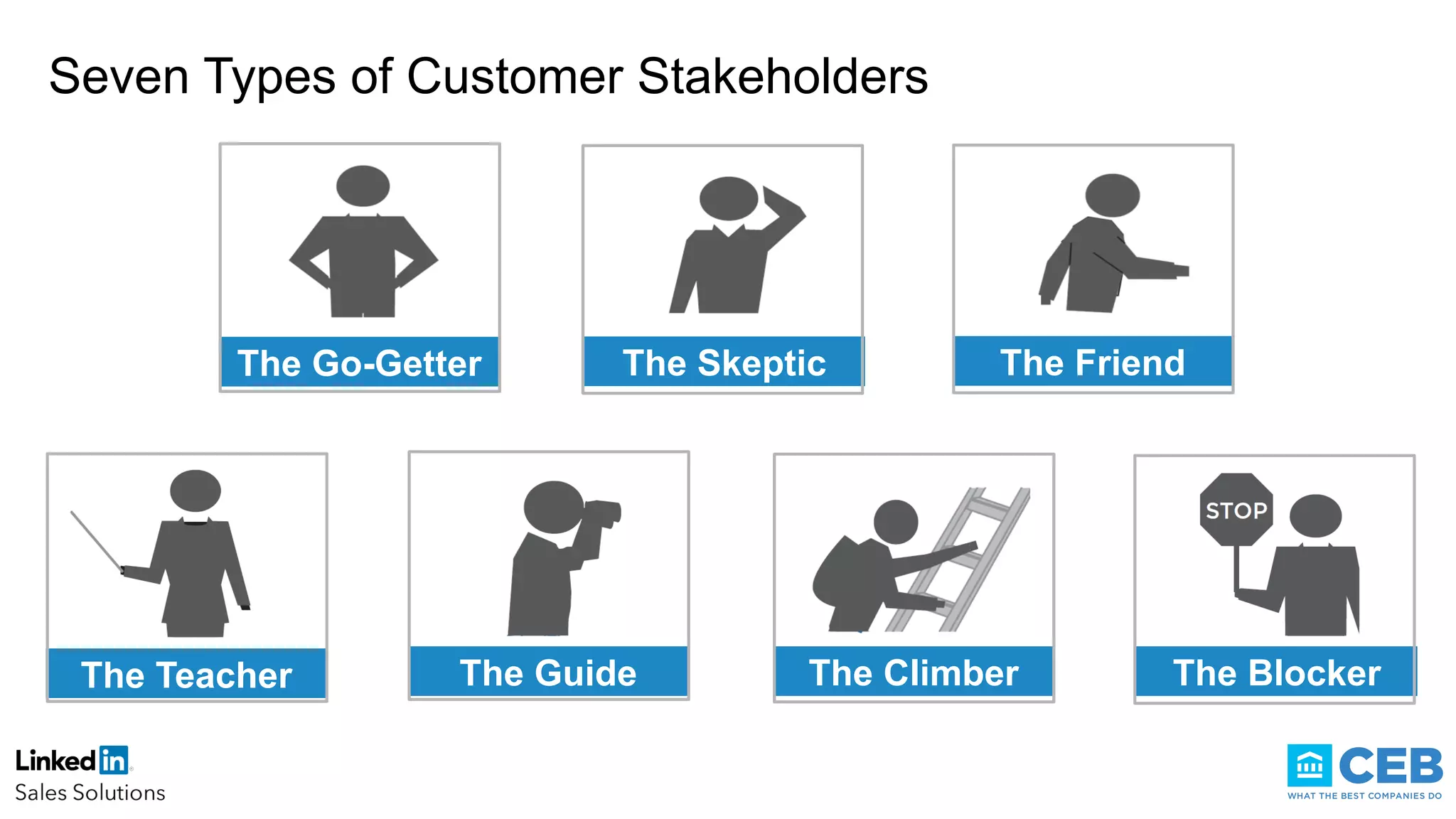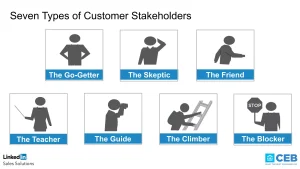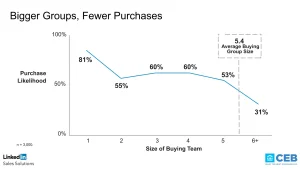Listen now – 7+1 Challenger Customer Personas Every SaaS Needs to Know
If you’ve been in SaaS for any length of time you’ve probably experienced “prospect ghosting”, where a once excited prospect drops off the radar. That committed deal is now closed/lost.
You and your team reflect:
- Is it a problem with the product?
- Maybe the sign-up process is faulty?
- Is customer onboarding a problem?
It could be none of those!
It could be that you didn’t realise that you have a challenger customer, and more people than your champion need to be persuaded.
As discussed in our previous post on SaaS sales, there are 5.4 Challenging Reasons Your SaaS Needs a Sales Team.
In addition to that, your SaaS sales team is going to experience some of the 7 customer personas. Plus you need to turn your champion into a mobilizer. Being a fan isn’t enough these days.
How to handle the 7 challenger customer personas
If you’ve been in sales for any amount of time, you will have an instinct by which you judge people in your prospect’s organization.
The researchers behind the Challenger Customer put a bit of science around it. When you read down this list of personas, I bet you can imagine people you’ve met like this in real life. I know I can!
1. The Go-Getter
Every org seems to have a person that is known for “getting shit done”. They don’t waste time on useless projects. “If John is on it, it must be worth doing!”
This person is your advocate for good ideas who delivers results. The Go-Getter that will take care of the internal selling of your proposition.
If a Go-Getter isn’t involved in your customer project, then you need to find one! Ask your champion (more on that later) to find this kind of person. Give examples of when helping a Go-Getter at other clients has helped them win. Make it about them. Definitely don’t say “We’ve less chance of winning your business without your Go-Getter being onboard”. I mean, that’s true, but that’s about you not them, isn’t it?
2. The Skeptic
This is my personal favourite. In all of my years on the front-line of tech sales, this was my target as a Field CTO: who’s asking us all the difficult questions?
This isn’t a “Negative Nelly” (more on the Blocker next), but it’s that well-respected, thoughtful, straight-talking gatekeeper you need to win over.
If you’ve been doing your job right, you should be armed with a bundle of FAQs that previous skeptics have asked you.
In fact, you should leap at the chance to find and help the skeptic with as many awkward questions as you can.
Remember — you’re the expert, right? You’re here to help them with your commercial insight, and you can do that with a list of skeptical questions.
They will love you for this. Guaranteed.
If you feel uncomfortable with sharing difficult questions about your SaaS… then you’re in trouble.
NOTE: if you only deal with a skeptic, you might be just helping them to competitively judge the market with no buyer intent. As with all these personas, just dealing with one is not enough.
3. The Friend
This is your ally. Someone willing to share ideas. They listen. They tell you things that will help you.
But your friend isn’t usually the decision maker, or a go-getter, or a skeptic (they might be, but they’ll not ask you difficult questions because you’re a friend, right?)
Sometimes it’s not obvious to others in the prospects organization that the friend is working with you. Sometimes it’s like having a spy on the inside!
4. The Teacher
Recognized and respected internally as someone who’s always learning and sharing, this is the person you need to get your commercial insight to.
You’re the expert in your field. You have a wealth of information that nobody else has. This is the juice you need to set loose via the teacher.
This is less about your features and functions and more about the problems you are going to solve for them, and why that matters — especially compared to industry thought leadership and competitive intelligence.
Teachers like context — do you understand their vertical? Where do you fit in the horizontal competitive landscape? Is this a big bet, or a little bet? Why should they care? Why are you the best?
Think about your positioning that’s the foundation of your messaging: this is the target for that, because they’ll amplify and spread your message PLUS they are likely to teach you a thing or two, which is great intelligence.
5. The Guide
Navigating an enterprise is something seasoned sales people are experts at. And they always have a friendly guide on the inside.
They’ll share inside information such as staff reporting structures, who the key players are, and what motivates them so you can align with their priorities and objectives.
They’ll make meetings, open doors, and help you prepare as well as giving you feedback and progress reports.
This isn’t quite a mobilizer, but it’s the next best thing.
6. The Climber
These last two can be a bit negative, but they’re important to spot and handle.
The climber will pick you up if you are helpful to them, not necessarily the organization. “Great,” you might think. “If I align with the climber then they’ll help me win.”
Hold on a moment.
The odds are that the other personas in the customer org know this person is a climber. There might be people who want to stop the climber at all costs. That means if you are tightly aligned to the climber, and someone shoots them down, then you’re going down with them.
There’s another aspect to this: the climber might just be using you for hidden motives. They might actually prefer a competitor — maybe even an internal project — and they extract as much info out of you as possible before discarding you once your usefulness is at an end.
7. The Blocker
We’ve saved the worst ’till last 🙂
If I was to be charitable, I’d say this person is a blocker because they like the status quo. They despise change. For them the pain of change will always be more than the pain of same.
They will cross their arms and use phrases like “We don’t work like that.” <– true story from my VMware days, when we were all about change and pain.
The good news is that everyone else knows this Negative Nelly is always complaining, hates change, and they discount their opinion.
In fact, others are often suspicious of anything the blocker is happy about!
So, that’s the 7 challenger customer personas… now onto the main protagonist: the mobilizer! You can’t win enterprise SaaS sales without one of these. The 7 personas above are players, but the mobilizer is the star of the show.
Turning fans and champions into mobilizers
At the top of this piece we talked about “prospect ghosting”. How that excited fan wanted to champion your product… but then disappeared during sign up or onboarding… and nobody knows why. People suspect it’s a product or process issue, but maybe it’s a challenger customer issue?
A mobilizer won't ghost you. But who is this mystery person? An individual that will fight for you and your solution, acting as an internal champion, helping you to navigate the stakeholders who have an influence on the decision.
Steve Chambers
You should seek to turn fans and champions into mobilizers. You need to arm them with a map, a plan, and tools to mobilize the other personas on your behalf.
Some people are just not up to this task and will feel uncomfortable: that’s ok. They’re probably more of a Friend or Guide than a Mobilizer.
But if you’re good at creating mobilizers — map, plan, tools — then you are likely to create a long-term partnership that will last beyond the current deal.
But how?
First of all, don’t try to mobilize the wrong person. If you’ve been ghosted by someone: you know they’re not a mobilizer. Maybe they were a different persona: check your radar and get it fixed!
Secondly, remember: you are the expert in what you do and they are the expert in their organizations. You’re a team.
Give them all of your mobilizer expertise from previous wins. Specifically:
- Give them a map. Show them how the land usually lies, and this starts with personas — tell them, “Hey, we know that finding and helping a skeptic is really helpful to companies like yours.” Tell them a previous skeptic story. Then show them the skeptic FAQ. They’ll know who to talk to. Maps also include industry observations (analysts), their vertical insights (your competitor bank did X). This is the stuff that the Teacher also loves. Skeptic and Teacher are two sides of the same coin.
- Give them a plan. “Here’s how it normally goes, John… but everyone has some differences, so it might not be exactly like this…” They will find the Go-Getter required to do this.
- Give them tools. This can be business cases, ROI/TCO calculators, prebuilt presentations, recorded demos, lab or demo access — whatever they need.
If you mobilize someone in an enterprise then your chances of winning that deal go up exponentially. Knowing one or more of the personas is not enough. A singular fan or champion is not enough.
If you have a question or need more info — this is just a “simple” perspective! — then get in touch via Twitter, LinkedIn, or on Viewyonder.




